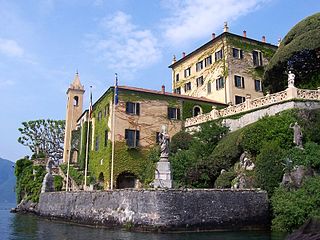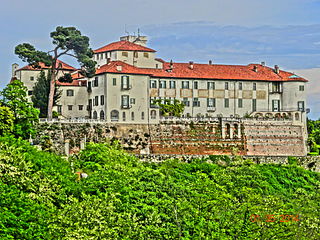
The Aeolian Islands, sometimes referred to as the Lipari Islands or Lipari group after their largest island, are a volcanic archipelago in the Tyrrhenian Sea north of Sicily, said to be named after Aeolus, the mythical ruler of the winds. The islands' inhabitants are known as Aeolians. The islands had a permanent population of 14,224 at the 2011 census; the latest official estimate is 15,419 as of 1 January 2019. The Aeolian Islands are a popular tourist destination in the summer and attract up to 600,000 visitors annually.

The provinces of Italy are the second-level administrative divisions of the Italian Republic, on an intermediate level between a municipality and a region. Since 2015, provinces have been classified as "institutional bodies of second level".

Città di Castello ; "Castle Town") is a city and comune in the province of Perugia, in the northern part of Umbria. It is situated on a slope of the Apennines, on the flood plain along the upper part of the river Tiber. The city is 56 km (35 mi) north of Perugia and 104 km (65 comune of Città di Castello has an exclave named Monte Ruperto within Marche.

Formello is a town and comune in the Metropolitan City of Rome. It is located southwest of the Monti Sabatini, within the Regional Park of Veii. The communal territory sits on large deposits of tuff, which is intensively mined in the area.

The Villa del Balbianello is a villa in the comune of Lenno, a province in the north of the Lombardy region of Italy, overlooking Lake Como. It is located on the tip of the small wooded peninsula of Dosso d'Avedo on the western shore of the south-west branch of Lake Como, 1500 meters east from the Isola Comacina. The villa is famous for its elaborate terraced gardens.

Casalzuigno is a comune (municipality) in the Province of Varese in the Italian region Lombardy, located about 60 kilometres (37 mi) northwest of Milan and about 14 kilometres (9 mi) northwest of Varese.

Castello della Manta is a castle at Manta near Saluzzo, Province of Cuneo, region of Piedmont, in northern Italy.

Studio Festi is an Italian artistic project and production centre bringing into being shows and grand installations. Founded in 1982, by Valerio Festi and Monica Maimone, Studio Festi operates from its main offices in Velate, its workshop in Venegono Superiore (Varese) and, in 2010, it set up a branch in São Paulo, Brazil.

Villa Della Porta Bozzolo is a villa located at Casalzuigno in the province of Varese, northern Italy. It was donated by the heirs of the Italian senator and pathologist Camillo Bozzolo to the Fondo per l'Ambiente Italiano—the National Trust of Italy—who now manage it.

The Castle of Avio is a medieval castle in the comune Avio, Trentino, northern Italy. It is currently held by the Fondo per l'Ambiente Italiano (FAI). It is one of the several castles commanding the Vallagarina valley of the Adige River. It features several rooms with medieval frescoes.

Torba Abbey, otherwise Torba Monastery is a former Benedictine nunnery in Torba, a frazione of Gornate Olona, Lombardy, Italy, in the Castelseprio Archaeological Park. The buildings are part of a list of structures associated with "Longobards in Italy, Places of Power ", that is dating to the Lombard era of the early middle ages. The abbey was entered on the UNESCO List of World Heritage Sites in June 2011.

Laurenzana Castle is a former 12-13th-century castle, now in dilapidated state, standing in a rocky outcrop above the town of Laurenzana in the Basilicata region of Italy.

The Navile is a canal in Emilia-Romagna, northern Italy. It originates from the Reno canal, which owes its name to the Reno River, from which it originates at the Chiusa di Casalecchio di Reno.

The Visconti-Castelbarco Castle is a castle of mediaeval origin located in Cislago, Lombardy, Northern Italy. Since the 13th century it belonged to a cadet branch of the Visconti House. In the 18th century it became a property of the Castelbarco family.

Palazzina Appiani is a historical building located in Milan, northern Italy. It was built as the entrance hall of the arena at the beginning of the 19th century by the French, who occupied Milan in 1796. Its original function was to be the official gallery and guest residence to host Napoleon's family during his public appearances. It is located in Parco Sempione, the biggest park in the city, which also comprises the Sforza Castle and the Arch of Peace. Adjacent to the Arena Civica, the Palazzina is now entrusted to FAI – Fondo Ambiente Italiano.

Masino Castle is a hill-top castle located in Caravino, Italy.

The Visconti Rocca of Urgnano, also known as Visconti Castle or Albani Rocca, is a middle age fortification in Urgnano, Lombardy in northern Italy. It was built in 1354 by Giovanni Visconti, Archbishop, and Lord of Milan. Today, it is the property of the Urgnano municipality.
















